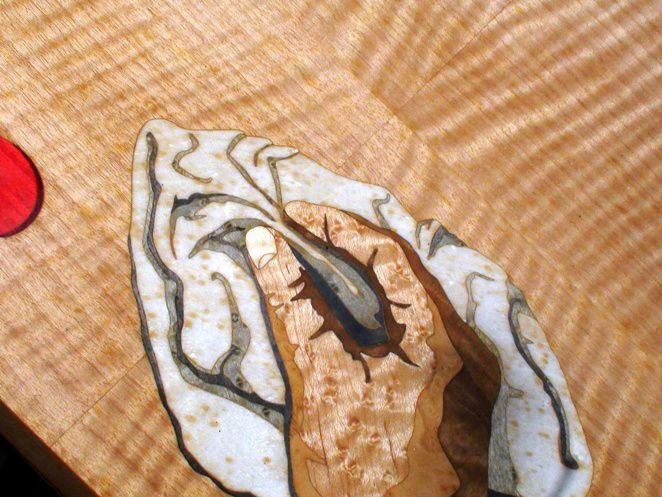Question
I did this wine rack last year, put it away for 6 months, and pulled it out recently. Now there are spots.
Here is the process. Veneers glued on ultralight MDF with Unibond 800. The white and grays are dyed veneers; everything else is natural (anegre, burls in the hands). Top was sealed with a thixotropic poly acrylic (ICA), sanded down for a full grain fill, then top coated with 5 coats of ICA polyacrylic.
I have done this process on many pieces with no problems, but nothing this light - mostly darker veneers like sapele. So I am trying to think back on what made this project different. I sanded the sealer back to the actual wood. Normally I leave more sealer material. But I have the same problems on the sides of the unit, where there was an open grained finish, and with the curved nature of the sides I hand sanded, so I left a lot more sealer material. The spotting is on the side as well, but very slight.
I talked to the ICA product specialist, and he thinks it is coming from underneath. Like I said, this problem wasn't there when it was sprayed. It was stored in complete darkness. If you look closely, you can see in on the anegre as well. Thoughts?

Forum Responses
(Finishing Forum)
From contributor M:
First off, that work is awesome, like so many of your pieces that I have seen photos of!
I have done most of my veneering with Unibond, and as much as I like the glue, I have had similar looking spots bleed through on a few projects. One was on some chen chen, another on some maple, and the third was on some cherry. In the case of the chen chen, we saw a fair amount of bleed through right out of the press, and it sanded out okay. But after a few weeks the spots appeared, and looked very similar to your photo.
I don't know if that is what you have going on, but it reminds me of my past project. Since then I have been using Uniblocker to help with bleed through, and it really seems to help. Did you use it on that piece?
These spots are caused by undissolved crystals in the catalyst. The powdered catalyst of Unibond is made of mostly walnut and pecan shell flour with an acid salt as the actual catalyst which is a small part of the powder. These acid salt crystals are similar to the size of common table salt. If you put your hand in the powder you can feel them. If, when mixing the liquid resin in with the catalyst, these crystals are not fully dissolved, then they sit under the veneer in concentration and slowly leach out over time, leaving spots in the veneer.
You tend to see this mostly on lighter woods, especially bleached, and these white stained veneers. The solution is to be sure these crystals are fully dissolved by mixing with an electric mixer in a drill, then letting the mixture sit for a few minutes and then mixing again. To be absolutely sure, you could put on a thin glove and feel the mixed glue for any undissolved crystals.
The unfortunate thing is nothing can be done at this point because it is a chemical staining between the veneer and the acid salt crystals.